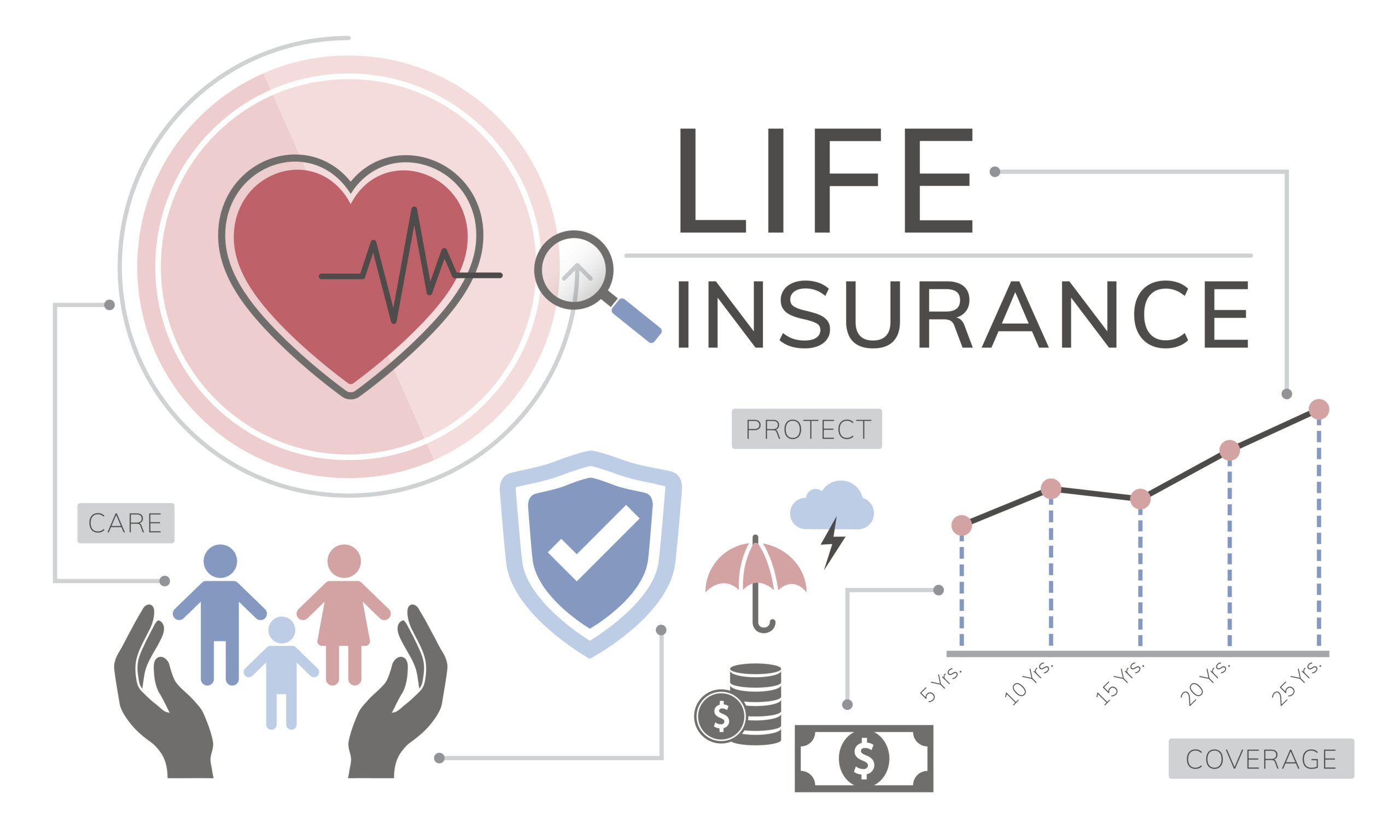Determining the Right Life Insurance Coverage
- 1 Key Factors in Determining Life Insurance Coverage
- 1.1 Debt
- 1.2 Replacing Lost Income
- 1.3 Insuring Loved Ones
- 2 Methods To Find Out How Much Coverage You Need
- 2.1 Years-Until-Retirement Approach
- 2.2 Maintaining Lifestyle Approach
- 2.3 DIME (Debt, Income, Mortgage, Education) Approach
- 2.4 The Manual Approach
- 3 Guidelines for Determining Your Life Insurance Needs
- 4 Choosing Between Term and Whole Life Insurance
- 5 FAQs
- 5.1 When calculating my life insurance needs, how do I factor in future expenses like college costs?
- 5.2 What happens if my financial situation changes after purchasing a life insurance policy?
- 5.3 Are there any tax implications associated with life insurance payouts?
- 5.4 Can I cancel or change my life insurance policy if my needs change?
- 5.5 What happens if I miss a premium payment on my life insurance policy?
- 5.6 Can I borrow against the cash value of my whole life insurance policy?
- Determining Coverage: Calculate the face value of your life insurance policy based on factors like debt, income replacement, and insuring loved ones.
- Consideration Methods: Use various methods like the Years-Until-Retirement, Standard-of-Living, or DIME approach to determine your life insurance needs.
- Guidelines: Include life insurance as part of your financial strategy and engage in open discussions with your family about coverage needs.
Choosing a life insurance policy starts with a critical question. You must determine how much money your dependents will need if you pass away. Your life insurance’s “face value” depends on a few factors, and the minimum required coverage varies among individuals. Experts suggest getting coverage of at least ten times your annual income. However, your unique circumstances may mean you need a higher or lower amount of protection. Let’s cover this in more detail.
Key Factors in Determining Life Insurance Coverage

Debt
Life insurance can pay off your debts. It can cover student loans, car loans, mortgages, credit cards, and personal loans. If you have any of these debts, your policy should protect them. For example, if you have a $200,000 mortgage and a $4,000 car loan, your policy should cover at least $204,000. Including a little extra is wise. It covers interest and charges.
Replacing Lost Income
A primary purpose of life insurance is to serve as income replacement. You are the leading financial provider for your dependents. Say you earn $40,000 a year. Your policy should offer a larger payout to replace your yearly income. You’ll want more life insurance coverage if you are a high-earner. It’s wise to include a bit extra for inflation. It adds security.
Life insurance specialists recommend getting coverage. It should be equal to at least ten years of your salary. For instance, if your annual income is $40,000, the suggested coverage would be $400,000. It’s wise to add a cushion for inflation and unforeseen expenses. So, a good value for the policy here might be $500,000. This ensures your family’s financial stability for at least a decade.
You can begin the consideration process once you determine the required face value for your insurance policy. Use an online insurance estimate calculator to see how much the coverage will cost. Not that regular life insurance will require a medical exam, but it comes at a lower cost than no medical life insurance.
Insuring Loved Ones
The general rule here is to insure only those individuals who would have a financial setback if they passed away. Losing a child is unfortunate. But it doesn’t cause financial loss. Raising children costs money. The death of a spouse who contributes to the household income creates a situation. It has both emotional and economic effects.
Methods To Find Out How Much Coverage You Need
To calculate your life insurance needs, many insurers suggest a baseline amount. This is usually at least 10 times your annual salary. For instance, if your yearly income is $50,000, aiming for $500,000 in coverage is a reasonable starting point. Moreover, some experts suggest adding $100,000 in coverage for each child. This is on top of the initial 10 times the salary amount.
Years-Until-Retirement Approach
Another way to find your life insurance is to multiply your yearly salary. Do this by the years until retirement. For instance, consider a 40-year-old earning $20,000. They would need $500,000 in life insurance. They get this by applying the Years-Until-Retirement Method: 25 years times $20,000.
Maintaining Lifestyle Approach
The Standard-of-Living Method hinges on finding the funds survivors need. They need the funds to keep their standard of living if the insured person dies. The calculation involves multiplying that amount by 20. The concept is that survivors can withdraw 5% each year from the death benefit. This amount is the same as the standard of living needed. They do this while also investing in the death benefit principle. This investment yields a return of 5% or higher. Experts refer to this approach as the Human Life Value (HLV) method.
DIME (Debt, Income, Mortgage, Education) Approach
It is introducing another approach known as DIME. It focuses on a small coverage amount to address family expenses if the person dies. The DIME method advocates for enough coverage to settle all debts. This includes the mortgage. It will fund your children’s education and replace your income until they are 18.
In such cases, use the income replacement calculation explained earlier. Factor in the person’s income. This principle extends to business partners with whom you share financial ties. For instance, think about someone you share the responsibility with. You both pay the mortgage for a co-owned property. It would be best if you considered a policy for that person. Their death could affect your finances.
The Manual Approach
Discover your personalized target coverage amount. Do this by subtracting your cash from your debts.
Step 1: Sum up the following elements to determine your financial obligations.
- Multiply your annual salary by how many years you aim to replace that income.
- Include your mortgage balance.
- Account for any other outstanding debts.
- Consider future expenses like college fees and funeral costs.
- Check the cost of replacing services provided by a stay-at-home parent. This includes childcare, if applicable.
Step 2: Subtract the value of liquid assets from the total. These assets include savings, existing college funds, and current life insurance policies. The resulting figure represents the required amount of life insurance.
Guidelines for Determining Your Life Insurance Needs

Consider these helpful tips as you assess your coverage requirements:
- Include life insurance as part of your comprehensive financial strategy. Your plan should cover future expenses, like college costs. It should also consider the growth of your income or assets.
- Avoid cutting corners. Your income and expenses will likely increase over time. So, it’s hard to predict their exact size. But a buffer makes sure your spouse and children can keep their lifestyle.
- Engage in open discussions with your family about the numbers. Find out how much money your spouse thinks the family would need to continue without you. Ensure your estimates align with their perspective. For instance, consider if your family would need to replace all your income—or at least some of it.
- Explore the option of purchasing several more minor life insurance policies. Diversify your coverage to adapt to changing needs over time. For instance, consider getting a 30-year term life insurance policy. It will provide for your spouse until retirement. Also, get a 20-year term policy. It will support your children until they graduate. Compare life insurance quotes to gauge the associated costs.
Choosing Between Term and Whole Life Insurance
Term life insurance offers coverage for a fixed duration, like 10, 20, or 30 years. When determining coverage, consider the desired duration of your term policy. For example, you may need life insurance to protect your income. It would be best if you had it until your kids reach college. A 20-year policy may be right. If your goal is to cover your mortgage, opting for a 30-year term policy might be more fitting.
Term Life Insurance:
Affordability: Term life insurance is typically more affordable than whole life insurance, making it an attractive option for individuals looking for coverage on a budget. With term life insurance, you pay premiums for a specified term, such as 10, 20, or 30 years, and if you pass away during that period, your beneficiaries receive the death benefit.
Flexibility: Another advantage of term life insurance is its flexibility. You can choose the term length that aligns with your needs and financial goals. Whether you need coverage for a certain period to pay off a mortgage or until your children reach adulthood, term life insurance allows you to tailor the policy to your circumstances.
Pure Insurance Protection: Term life insurance provides pure insurance protection without any cash value component. This means premiums are solely allocated toward the death benefit, ensuring your beneficiaries receive a predetermined amount if you pass away during the policy term.
Whole Life Insurance:
Lifetime Coverage: Unlike term life insurance, whole life insurance covers your entire life as long as premiums are paid. This lifelong coverage offers peace of mind, knowing your beneficiaries will receive the death benefit regardless of when you pass away.
Cash Value Accumulation: One of the distinguishing features of whole life insurance is its cash value component. A portion of your premiums goes toward building cash value over time, which grows on a tax-deferred basis. You can access this cash value through policy loans or withdrawals for various financial needs, such as supplementing retirement income or covering unexpected expenses.
Guaranteed Premiums and Death Benefit: Whole life insurance policies typically have guaranteed premiums and death benefits, providing predictability and stability. The premiums remain level throughout the policy’s life, allowing you to budget accordingly, and the death benefit is guaranteed to your beneficiaries, ensuring financial security.
How To Between Term and Whole Life Insurance:

Consider Your Financial Goals: When deciding between term and whole life insurance, consider your financial goals and objectives. If you need coverage for a specific period and prioritize affordability, term life insurance may be the better option. However, if you seek lifelong coverage with cash value accumulation and are willing to pay higher premiums, whole life insurance may better suit your needs.
Evaluate Your Budget and Affordability: Evaluate your budget and determine how much you can spend on life insurance premiums. Term life insurance typically offers lower premiums initially, making it more budget-friendly for many individuals. Whole life insurance premiums are higher but provide lifelong coverage and cash value accumulation.
Assess Your Risk Tolerance: When choosing between term and whole life insurance, assess your risk tolerance and investment preferences. Term life insurance offers straightforward coverage with no investment component, making it suitable for individuals who prefer a simple, no-frills approach. Whole life insurance combines insurance protection with cash value accumulation, appealing to those seeking coverage and investment growth.
FAQs
When calculating my life insurance needs, how do I factor in future expenses like college costs?
Consider including future expenses like college costs in your life insurance coverage calculation. You can use methods like adding a specific amount per child or using the Standard-of-Living approach to ensure these expenses are covered in your policy.
What happens if my financial situation changes after purchasing a life insurance policy?
If your financial situation changes after purchasing a life insurance policy, such as an increase in income or additional dependents, you may need to reassess your coverage needs. You can typically adjust your policy or purchase additional coverage to accommodate these changes.
Are there any tax implications associated with life insurance payouts?
Life insurance death benefits are generally received tax-free by the beneficiaries. However, if the policy has accumulated cash value and you withdraw funds or surrender the policy, there may be tax implications. It’s essential to consult with a tax advisor to understand any potential tax consequences.
Can I cancel or change my life insurance policy if my needs change?
Yes, you can typically cancel or change your life insurance policy if your needs change. However, the process and potential consequences may vary depending on the type of policy and the insurance provider. It’s recommended to review the terms and conditions of your policy and consult with your insurance agent or advisor for guidance.
What happens if I miss a premium payment on my life insurance policy?
If you miss a premium payment on your life insurance policy, the policy may lapse or be subject to a grace period, depending on the terms of the policy. During the grace period, you may have the opportunity to reinstate the policy by paying the overdue premium. It’s essential to contact your insurance provider promptly to discuss options if you miss a payment.
Can I borrow against the cash value of my whole life insurance policy?
Yes, if you have a whole life insurance policy with cash value accumulation, you may be able to borrow against the cash value through policy loans. These loans typically have favorable terms, such as low interest rates, and can be used for various financial needs. However, it’s essential to understand the terms and potential implications of borrowing against your policy before proceeding.

















